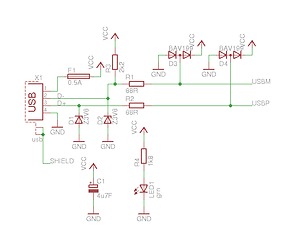I’ve already had a programmer for Atmel’s AVR microcontrollers, but I couldn’t use it in my lab, because my laptop doesn’t have a LPT port. So I decided to make a new programmer with USB connection. I’ve found an open source programmer AVR doper, and for the basis I took a modified version from the http://www.kreuzholzen.de web page. I designed a new singled sided PCB board, that I was able to make at home. The programmer is compatible with STK500v2.
The programmer is controlled with an ATMEGA8 microcontroller. The microcontroller is clocked with 12Mhz crystal with 22pF capacitors. We put the decoupling capacitors (100nF) on microcontroller supply pins and AREF pin. Reset pin is pulled up to 5V with a 10k resistor and protected against interference with 100nF capacitor. On pin PB7 is a LED diode, indicating the programming in progress. The signals are connected to avr as indicated in schematics.
To convert voltage levels from microcontroller from programmer to the programmed microcontroller we use 74hc126. On all signal lines is also a bav99 diode for ESD protection and beads and 10pF capacitors to USB shield against interference.
Three settings are available on avr programmer: 1. Connecting pin SLOW_SCK from microcontroller to GND sets lower programming speed. We can use this setting if our software doesn’t support it. The lower speed of programming is needed when the programmed Atmel microcontroller runs at lower frequency (such as for example 32kHz). 2. Pin ISP_TMOSI pulled to GND with 1k resistor. This settings select the type of USB device the programmer emulates. The recommended setting is the switch in connected position. This sets the type of device to HID, otherwise the device of our programmer will be a serial modem. 3. With this setting we connect the supply of programmer to the supply of programmed avr, so the programmed chip can as well be supplied from the USB port.
For more detail: USB AVR programmer

